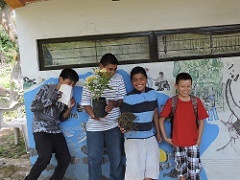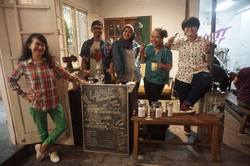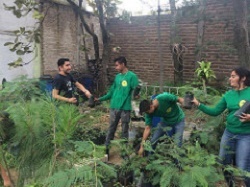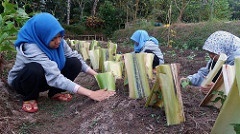We are at a global tipping point. Carbon levels are critical, the global population is growing to a level that is unsustainable unless we make significant changes to the way we live, and we are facing a warming planet. It is easy to be concerned about what the future holds and to imagine the worst. However, perhaps the best way to find out what our planet will actually look like in 50 years is to ask our young people what they care about and how they plan to shape our planet's future.
Together with Levi Strauss & Co.,(read more about how the program works here) we set out to do just that. Working with a team of grantmakers in 5 countries, we have funded 24 extraordinary young people aged 25 or under who not only share these concerns but have stepped up to address them within their communities. Because these grants are made face to face through relationships, we have been able to reach young people who may otherwise never have been funded - people who are too young to have bank accounts, who do not speak English, or who do not have regular access to the internet.
What's more, as grantmakers, we believe that the best people to solve the problems facing a community are those who have lived them. They know what matters most, they know how the issues affect their communities, and they are able to imagine truly creative, appropriate solutions. This is especially true for young people - they see things differently, they are not scared to make a change, and they have a lot at stake.
And that is how we arrive at this latest group of extraordinary projects. From a pop-up restaurant in Indonesia that uses food to show people that biodiversity matters, to a rooftop garden in Atlanta which provides a safe haven for pollinators while educating the community, these young people are doing it their way, and they give us hope for the future! Read on to meet 8 more of our latest young change-makers!
 The Youth of Mezcala de Asuncion, Clean Lake - Clean Home, Mezcala de la Asuncion, Jalisco, Mexico
The Youth of Mezcala de Asuncion, Clean Lake - Clean Home, Mezcala de la Asuncion, Jalisco, Mexico
Lake Chapala is the largest lake in Mexico and is a haven for biodiversity. However, it is located only an hour South of the huge city of Guadalajara and is facing increasing environmental pressure. After becoming frustrated with trash washing up on the shores of their lake, seeing animals struggle with pollution, and watching things get worse every year, 15 young people formed a plan. So young that they meet to plan their work in a safe community space after school, they plan to gather and recycle trash to sell, produce a playground from recycled materials, and educate their community by setting up recycling centers.
Yessy Hendrika Rambu Yaku Lawa, Cultivating Wild Tubers To Reduce Food Insecurity, Central Sumba, Indonesia
On the island of Central Sumba, Indonesia, water is scarce and the dry season lasts over three-quarters of the year. For residents of the island, this long period of drought brings with it food insecurity and the threat of fire. Current farming practices are destroying the environment and placing communities at risk. Yessy and her team are encouraging cultivation of alternative, ecologically sound options which will conserve the island while also nourishing the community.
 Gloria Mario Virginia, Please Eat Wildly, Yogyakarta, Indonesia
Gloria Mario Virginia, Please Eat Wildly, Yogyakarta, Indonesia
Gloria and her team are launching their pop-up restaurant, "Please Eat Wildly". Believing that the key to engaging people is showing them how easy and tasty it is to obtain and prepare wild plants as a sustainable food source that is not reliant on industrial agriculture, irrigation, and all of the problems that come with it, Gloria and her team will serve only wild crops while providing education center nutrition, agriculture, and the environment.
Carson Dann, RoofBuzz, Athens, Georgia, USA
Life in the city is tough for our vital, often overlooked, pollinators. Facing heavy use of pesticides, urbanization and concretization, noise, traffic, and pollution, it is no surprise that pollinator numbers continue to fall. However, on the campus of the University of Georgia, a safe-haven awaits! Carson Dann plans to turn a university rooftop into a pollinator paradise that will provide respite from the surrounding hazards while educating her community on protecting pollinators.
 Jose Luis Lopez Carlos, Nixtiquil Community Reforestation and Forest-Fires Project, Jalisco, Mexico
Jose Luis Lopez Carlos, Nixtiquil Community Reforestation and Forest-Fires Project, Jalisco, Mexico
In Jalisco, Mexico the Nixticuil forest receives no protection from the government. In the absence of assistance, young people in the community have stepped up to protect their forest themselves. Forming the Save the Forest Committee, they work steadily to fight fires, carry out reforestation by growing trees in a nursery and caring for them once planted in the forest, and to educate young people about the importance of the forest. These community activists have few tools or protective equipment and work in difficult conditions. This grant will provide them with tools to fight the fires and nursery supplies for reforestation.
Adriana Lopez Montoya, Santa Anita Farm School, Santa Anita, Tlajomulco de Zuniga, Mexico
Located on a 'frontier' between urban sprawl and rural land, Santa Anita is a community between two worlds. Seizing this opportunity to get in on the ground floor and promote practices which will ensure the sustainable future and health of their community, the Santa Anita Farm School has a mission to reduce the impact of increasingly dense habitation, while also meeting their increased food needs without going down the devastating path toward industrial agriculture which places production and profit above all else.
 Runinten, Preservation and Utilization of Local Legumes as a Food Source for Local Community, Lombok Island, Indonesia
Runinten, Preservation and Utilization of Local Legumes as a Food Source for Local Community, Lombok Island, Indonesia
On Lombok island in Indonesia, soils are becoming depleted, crops require heavy fertilization, and agriculture is contaminating vital water sources. After learning about the benefits of legumes to both the soil and people, eighth-grader Runinten and her friends have picked up on the importance of pulses as a potential crop for the dry soil of their island. These eighth-graders have set out to research, collect, and conserve local varieties of legumes which will then be cultivated and distributed to their community to increase local food security and diversity and to replenish the soils of their island.
Robinson Ranjawali, Utilizing Coastal Plants as Food Sources and For Soil Restoration, East Sumba, Indonesia
Robinson Ranjawali has a vision for the future of his remote coastal community on the island of East Sumba in Indonesia. Located on land that has come to be considered infertile, the community is reliant upon food that must travel from the nearest city - over 70 miles away. Importing food from the city contributes to pollution, fuels the rise of industrial agriculture, and leaves community members with little diversity in their diets. Many community members cannot see an alternative, but Robinson is out to change that! These crops will provide nutrient dense and sustainably grown food which will put the community back in control of what goes on their plate! Even better, by cultivating and caring for coastal species such as mangroves, the community will also be protecting the vulnerable coast from erosion.
Along with our partners at Levi Strauss & Co. and our global team of grassroots grantmakers, we are so proud to fund these innovative young leaders.
Do you have a project that can change the world? We welcome grant applications for Pollination Project seed grants, every day.
